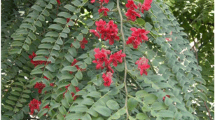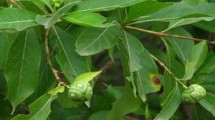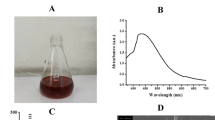Abstract
Pest insects causing damage to cultivable crops and food products by feeding, fecundity, and parasitizing livestock, also being a nuisance to human health. In consideration with human health, the World Health Organization reports that more than 50% of the world’s population is presently at risk from mosquito-borne diseases. Mosquitoes are primary vectors for major dreadful diseases such as yellow fever, malaria, and dengue fever, which infect millions of human beings all over the world and kill millions of peoples every year. The present research work was carried out to evaluate the antifeedant, larvicidal, pupicidal, larval, and pupal duration activity of Leonotis nepetifolia–mediated silver nanoparticles (AgNPs) against Spodoptera litura, Helicoverpa armigera, Aedes aegypti, and Culex quinquefasciatus. Biosynthesized AgNPs were characterized through various techniques such as UV–Vis spectrometer, X-ray powder diffraction (XRD), Fourier transform infrared spectroscopy (FTIR), scanning electron microscopy (SEM), energy-dispersive X-ray spectroscopy (EDX), transmission electron microscopy (TEM), dynamic light scattering (DLS), and zeta potential analysis. The AgNPs showed potential antifeedant activity of 78.77% and 82.16% against the larvae of S. litura and H. armigera, respectively. The maximum larval mortality rate (78.49% and 72.70%) and maximum pupal mortality rate (84.66% and 77.44%) were observed against S. litura and H. armigera. Mosquito larvae were tested with biosynthesized AgNPs, and recorded LC50 values were 47.44 ppm and 35.48 ppm on A. aegypti and C. quinquefasciatus, respectively. The histological examinations showed that the acceleration of the nanomaterial caused severe tissue damage in the epithelial and goblet cells in the larval midgut region of S. litura, H. armigera, A. aegypti, and C. quinquefasciatus. Biosynthesis of silver nanoparticles using L. nepetifolia is an ideal eco-friendly approach for the management of insect pests.

Graphical abstract










Similar content being viewed by others
References
Abbott WS (1925) A method of computing the effectiveness of insecticides. J Econ Entomol 18:265–267
Abd-Elnaby HM, Abo-Elala GM, Abdel-Raouf UM, Hamed MM (2016) Antibacterial and anticancer activity of extracellular synthesized silver nanoparticles from marine Streptomyces rochei MHM13. Egypt J Aquat Res 42:301–312
Adebayo-Tayo B, Salaam A, Ajibade A (2019) Green synthesis of silver nanoparticle using Oscillatoria sp. extract, its antibacterial, antibiofilm potential and cytotoxicity activity. Heliyon 5(10). https://doi.org/10.1016/j.heliyon.2019.e02502
Agnihotri S, Mukherji S, Mukherji S (2014) Size-controlled silver nanoparticles synthesized over the range 5–100 nm using the same protocol and their antibacterial efficacy. RSC Adv 4(8):3974–3983
Ahmed S, Ikram S (2015) Silver nanoparticles: one pot green synthesis using Terminalia arjuna extract for biological application. J Nanomed Nanotechnol 6:309. https://doi.org/10.4172/2157-7439.1000309
Al-Mehmadi RM, Al-Khalaf AA (2010) Larvicidal and histological effects of Melia azedarach extract on Culex quinquefasciatus Say larvae (Diptera: Culicidae). J King Saud Univ Sci 22:77–85
Arasu MV, Al-Dhabi NA, Saritha V, Duraipandiyan V, Muthukumar C, Kim SJ (2013) Antifeedant, larvicidal and growth inhibitory bioactivities of novel polyketide metabolite isolated from Streptomyces sp. AP-123 against Helicoverpa armigera and Spodoptera litura. BMC Microbiol 13:105
Baskar K, Muthu C, Ignacimuthu S (2014) Effect of pectolinaringenin, a flavonoid from Clerodendrum phlomidis, on total protein, glutathione S-transferase and esterase activities of Earias vittella and Helicoverpa armigera. Phytoparasitica 42(3):323–331
Behravan M, Panahi AH, Naghizadeh A, Ziaee M, Mahdavi R, Mirzapour A (2019) Facile green synthesis of silver nanoparticles using Berberis vulgaris leaf and root aqueous extract and its antibacterial activity. Int J Biol Macromol 124:148–154
Chawla V, Sathaye S (2017) Biosynthesis of silver nanoparticles using methanolic extracts of Acorus calamus, and assessment of its antioxidant and antimicrobial activity. J Med Plants Stud 5:358–363
Chinnaperumal K, Govindasamy B, Paramasivam D, Dilipkumar A, Dhayalan A, Vadivel A, Sengodan K, Pachiappan P (2018) Bio-pesticidal effects of Trichoderma viride formulated titanium dioxide nanoparticle and their physiological and biochemical changes on Helicoverpa armigera (Hub.). Pestic Biochem Physiol 149:26–36
Clement YN, Williams AF, Aranda D, Chase R, Watson N, Mohammed R, Stubbs O, Williamson D (2005) Medicinal herb use among asthmatic patients attending a specialty care facility in Trinidad. BMC Complement Altern Med 5(3). https://doi.org/10.1186/1472-6882-5-3
Datta R, Kaur A, Saraf I, Singh IP, Kaur S (2019) Effect of crude extracts and purified compounds of Alpinia galanga on nutritional physiology of a polyphagous lepidopteran pest, Spodoptera litura (Fabricius). Ecotox Environ Safe 30(168):324–329
Dhawan NG, Khan AS, Srivastava P (2013) A general appraisal of Leonotis nepetifolia (L) R. Br: an essential medicinal plant. Bull Environ Pharmacol Life Sci 2(8):118–121
Dinesh-Kumar A, Srimaan E, Chellappandian M, Vasantha-Srinivasan P, Karthi S, Thanigaivel A, Ponsankar A, Chanthini KMP, Shyam-Sundar N, Annamalai M, Kalaivani K, Hunter WB, Senthil-Nathan S (2018) Target and non-target response of Swietenia mahagoni Jacq. chemical constituents against tobacco cutworm Spodoptera litura Fab. and earthworm, Eudrilus eugeniae Kinb. Chemosphere 199:35–43
El-Shishtawy RM, Asiri AM, Al-Otaibi MM (2011) Synthesis and spectroscopic studies of stable aqueous dispersion of silver nanoparticles. Spectrochim Acta A Mol Biomol Spectrosc 79(5):1505–1510
Finney DJ (1971) Probit analysis, vol 383. Cambridge University Press, London, pp 68–72
FSSAI (2015) https://fssai.gov.in/upload/uploadfiles/files/Draft_WTO_Notification_Pesticides_23_11_2015.pdf
Ga’al H, Yang G, Fouad H, Guo M, Mo J (2020) Mannosylerythritol lipids mediated biosynthesis of silver nanoparticles: an eco-friendly and operative approach against chikungunya vector Aedes albopictus. J Clust Sci:1–9. https://doi.org/10.1007/s10876-019-01751-0
Gadhave KR, Hourston JE, Gange AC (2016) Developing soil microbial inoculants for pest management: can one have too much of a good thing? J Chem Ecol 42:348–356
Ghormade V, Deshpande MV, Paknikar KM (2011) Perspectives for nano-biotechnology enabled protection and nutrition of plants. Biotechnol Adv 29(6):792–803
Guarner J, Hale G (2019) Four human diseases with significant public health impact caused by mosquito-borne flaviviruses: West Nile, Zika, dengue and yellow fever. Semin Diagn Pathol 36:170–176
Holzwarth U, Gibson N (2011) The Scherrer equation versus the ‘Debye-Scherrer equation’. Nat Nanotech 6:534. https://doi.org/10.1038/nnano.2011.145
Huang SH, Xian JD, Kong SZ, Li YC, Xie JH, Lin J, Chen JN, Wang HFSZR (2013) Insecticidal activity of pogostone against Spodoptera litura and Spodoptera exigua (Lepidoptera: Noctuidae). Pest Manag Sci 70(3):510–516
Isman B, Koul O, Lucyzynski A, Kaminski J (1990) Insecticidal and antifeedant bioactivities of neem oils and their relationship to Azadirachtin content. J Agric Food Chem 38:1407–1411
Jemal K, Sandeep BV, Pola S (2017) Synthesis, characterization, and evaluation of the antibacterial activity of Allophylus serratus leaf and leaf derived callus extracts mediated silver nanoparticles. J Nanomater. https://doi.org/10.1155/2017/4213275
Jung WK, Koo HC, Kim KW, Shin S, Kim SH, Park YH (2008) Antibacterial activity and mechanism of action of the silver ion in Staphylococcus aureus and Escherichia coli. Appl Environ Microbiol 74:2171–2178
Jyoti K, Baunthiyal M, Singh A (2016) Characterization of silver nanoparticles synthesized using Urtica dioica Linn. leaves and their synergistic effects with antibiotics. J Radiat Res Appl Sci 9(3):217–227
Kandagal AS, Khetagoudar MC (2013) Study on larvicidal activity of weed extracts against Spodoptera litura. J Environ Biol 34(2):253–257
Klasen HJ (2000) Historical review of the use of silver in the treatment of burns. I Early uses. Burns 26(2):117–130
Lee H, Halverson S, Ezinwa N (2018) Mosquito-borne diseases. Prim Care 45:393–407
Logeswari P, Silambarasan S, Abraham J (2015) Synthesis of silver nanoparticles using plants extract and analysis of their antimicrobial property. J Saudi Chem Soc 19:311–317
Maheswaran R, Ignacimuthu S (2015a) Effect of confertifolin from Polygonum hydropiper L. against dengue vector mosquitoes Aedes aegypti L. Environ Sci Pollut Res 22(11):8280–8287
Maheswaran R, Ignacimuthu S (2015b) A novel biopesticide Ponneem to control human vector mosquitoes Anopheles stephensi L. and Culex quinquefasciatus Say. Environ Sci Pollut Res 22(17):13153–13166
Maheswaran R, Sukumaran S, Nattudurai G, Ignacimuthu S (2016) Bioefficacy of essential oil from Toddalia asiatica (L.) Lam. against dengue vector mosquitoes Aedes aegypti L. and Aedes albopictus Skuse. Indian J Nat Prod Resour 7(3):245–251
Maheswaran R, Baskar K, Ignacimuthu S, Maria Packiam S, Rajapandiyan K (2019) Bioactivity of Couroupita guianensis Aubl. against filarial and dengue vectors and non-target fish. South Afr J Bot 125:46–53
Mishra M, Gupta KK, Kumar S (2015) Impact of the stem extract of Thevetia neriifolia on the feeding potential and histological architecture of the midgut epithelial tissue of early fourth instars of Helicoverpa armigera Hübner. Int J Insect Sci 7:53–60
Mittal AK, Bhaumik J, Kumar S, Banerjee UC (2014) Biosynthesis of silver nanoparticles: elucidation of prospective mechanism and therapeutic potential. J Colloid Interface Sci 415:39–47
Morejón B, Pilaquinga BF, Domenech F, Ganchala D, Debut A, Neira M (2018) Larvicidal activity of silver nanoparticles synthesized using extracts of Ambrosia arborescens (Asteraceae) to control Aedes aegypti L. (Diptera: Culicidae). J Nanotechnol. https://doi.org/10.1155/2018/6917938
Murugan K, Roni M, Panneerselvam C, Aziz Al T, Suresh U, Rajaganesh R, Aruliah R, Mahyoub JA, Trivedi S, Rehman H, Al-Aoh HAN, Kumar S, Higuchi A, Vaseeharan B, Weik H, Senthil-Nathan S, Canale A, Benelli G (2018) Sargassum wightii-synthesized ZnO nanoparticles reduce the fitness and reproduction of the malaria vector Anopheles stephensi and cotton bollworm Helicoverpa armigera. Physiol Mol Plant Pathol 101:202–213
Nalini M, Lena M, Sumathi P, Sundaravadivelan C (2017) Effect of phyto-synthesized silver nanoparticles on developmental stages of malaria vector, Anopheles stephensi and dengue vector, Aedes aegypti. Egypt J Basic Appl Sci 4(3):212–218
Pirtarighat S, Ghannadnia M, Baghshahi S (2019) Green synthesis of silver nanoparticles using the plant extract of Salvia spinosa grown in vitro and their antibacterial activity assessment. J Nanostruct Chem 9(1):1–9
Priyadarshini KA, Murugan K, Panneerselvam C, Ponarulselvam S, Hwang JS, Nicoletti M (2012) Biolarvicidal and pupicidal potential of silver nanoparticles synthesized using Euphorbia hitra against Anopheles stephensi Liston (Diptera: Culicidae). Parasitol Res 111(3):997–1006
Ragavendran C, Mariappan T, Natarajan D (2017) Larvicidal, histopathological efficacy of Penicillium daleae against larvae of Culex quinquefasciatus and Aedes aegypti plus biotoxicity on Artemia nauplii a non-target aquatic organism. Front Pharmacol 8:773
Rajesh Kumar TV, Murthy JSR, Narayana Rao M, Bhargava Y (2016) Evaluation of silver nanoparticles synthetic potential of Couroupita guianensis Aubl., flower buds extract and their synergistic antibacterial activity. 3. Biotech 6(1):92
Rajput V, Minkina T, Sushkova S, Behal A, Maksimov A, Blicharska E, Ghazaryan K, Movsesyan H, Barsova N (2020) ZnO and CuO nanoparticles: a threat to soil organisms, plants and human health. Environ Geochem Health 42:147–158
Roni M, Murugan K, Panneerselvam C, Subramaniam J, Nicoletti M, Madhiyazhagan P, Dinesh D, Suresh U, Khater HF, Wei H, Canale A (2015) Characterization and biotoxicity of Hypnea musciformis-synthesized silver nanoparticles as potential eco-friendly control tool against Aedes aegypti and Plutella xylostella. Mater Sci Eng C 121:31–38
Sahayaraj K, Madasamy M, Radhika SA (2016) Insecticidal activity of bio-silver and gold nanoparticles against Pericallia ricini Fab. (Lepidaptera: Archidae). J Biopest 9(1):63–72
Saraswathi VS, Santhakumar K (2017) Green synthesis of silver nanoparticles mediated using Lagerstroemia speciosa and photocatalytic activity against Azo dye. Mech Mater Sci Eng J:9. https://doi.org/10.2412/mmse.72.63.602
Senthil-Nathan S (2013) Physiological and biochemical effect of neem and other Meliaceae plants secondary metabolites against Lepidopteran insects. Front Physiol 4:359
SPSS: IBM Corp. Released (2012) IBM SPSS Statistics for Windows, Version 21.0. IBM Corp, Armonk
Sudhakar C, Selvam K, Govarthanan M, Senthilkumar B, Sengottaiyan A, Stalin M, Selvankumar T (2015) Acorus calamus rhizome extract mediated biosynthesis of silver nanoparticles and their bactericidal activity against human pathogens. J Genet Eng Biotechnol 13:93–99
Tuncsoy BS, Tuncsoy M, Gomes T, Sousa V, Teixeira MR, Bebianno MJ, Ozalp P (2019) Effects of copper oxide nanoparticles on tissue accumulation and antioxidant enzymes of Galleria mellonella L. Bull Environ Contam Toxicol 102:341–346
Vanderzant ES, Richardson CD, Fort SW Jr (1962) Rearing of the bollworm on artificial diet. J Econ Entomol 55(1):140
Veerakumar K, Govindarajan M, Rajeswary M, Muthukumaran U (2014a) Mosquito larvicidal properties of silver nanoparticles synthesized using Heliotropium indicum (Boraginaceae) against Aedes aegypti, Anopheles stephensi, and Culex quinquefasciatus (Diptera: Culicidae). Parasitol Res 113(6):2363–2373
Veerakumar K, Govindarajan M, Rajeswary M, Muthukumaran U (2014b) Low-cost and eco-friendly green synthesis of silver nanoparticles using Feronia elephantum (Rutaceae) against Culex quinquefasciatus, Anopheles stephensi, and Aedes aegypti (Diptera: Culicidae). Parasitol Res 113(5):1775–1785
WHO (2005) Guidelines for Laboratory and Field testing of Mosquito larvicides, WHO/CDS/WHOPES/GCDPP/2005.13
Yang Y, Li Y, Wu Y (2013) Current status of insecticide resistance in Helicoverpa armigera after 15 years of Bt cotton planting in China. J Econ Entomol 106(1):375–381
Yasur J, Rani PU (2015) Lepidopteran insect susceptibility to silver nanoparticles and measurement of changes in their growth, development and physiology. Chemosphere 124:92–102
Yogarajalakshmi P, Poonguzhali TV, Ganesan R, Karthi S, Senthil-Nathan S, Krutmuang P, Vasantha-Srinivasan P (2020) Toxicological screening of marine red algae Champia parvula (C. Agardh) against the dengue mosquito vector Aedes aegypti (Linn.) and its non-toxicity against three beneficial aquatic predators. Aquat Toxicol 222:105474. https://doi.org/10.1016/j.aquatox.2020.105474
Zaki AM, Zaki AH, Farghali AA, Abdel-Rahim EF (2017) Sodium titanate-bacillus as a new nanopesticide for cotton leaf-worm. J Pure Appl Microbiol 11(2):725–732
Acknowledgments
The authors are thankful to Periyar University, Salem, Tamil Nadu, India, for providing laboratory support.
Author information
Authors and Affiliations
Corresponding author
Ethics declarations
Conflict of interest
The authors declare that they have no conflict of interest.
Additional information
Responsible Editor: Philippe Garrigues
Publisher’s note
Springer Nature remains neutral with regard to jurisdictional claims in published maps and institutional affiliations.
Rights and permissions
About this article
Cite this article
Manimegalai, T., Raguvaran, K., Kalpana, M. et al. Green synthesis of silver nanoparticle using Leonotis nepetifolia and their toxicity against vector mosquitoes of Aedes aegypti and Culex quinquefasciatus and agricultural pests of Spodoptera litura and Helicoverpa armigera. Environ Sci Pollut Res 27, 43103–43116 (2020). https://doi.org/10.1007/s11356-020-10127-1
Received:
Accepted:
Published:
Issue Date:
DOI: https://doi.org/10.1007/s11356-020-10127-1




